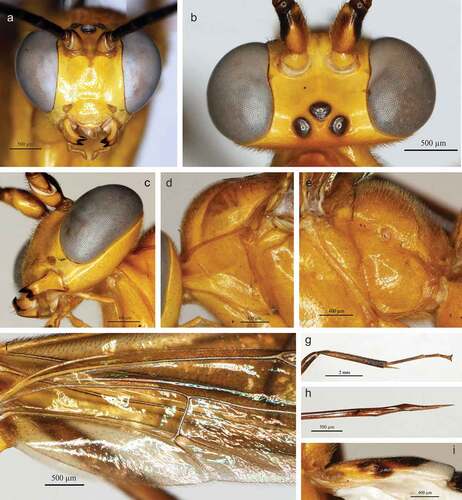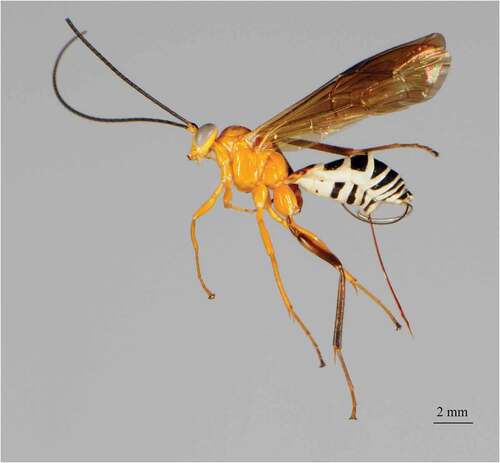Abstract
The genus Phytodietus Gravenhorst, 1829 is recorded from Papua New Guinea for the first time, based on a newly described species, P. (P.) guineus sp. nov. An identification key to the Australasian Phytodietus species is provided.
http://zoobank.org/urn:lsid:zoobank.org:pub:D23507BB-F353-4CDE-AB12-2B1DBD4B5F2B
Introduction
The genus Phytodietus Gravenhorst, 1829 (Hymenoptera: Ichneumonidae: Tryphoninae) comprises 129 species in three subgenera: Euctenopus Ashmead, Citation1900, Phytodietus Gravenhorst, 1829 and Weisia Schmiedeknecht, 1907 (Kostro-Ambroziak Citation2011a, Citation2011b, Citation2012a, Citation2012b; Kasparyan & Khalaim Citation2013; Bennett Citation2015; Kasparyan Citation2016; Kostro-Ambroziak & Broad Citation2016; Shimizu & Konishi Citation2018; Kostro-Ambroziak et al. Citation2020; Varga & Kostro-Ambroziak Citation2020). Although the genus is distributed worldwide, little is known about this taxa in Australasia. Three species are known from Australia: P. (P.) celsissimus Turner, 1919, P. (W.) queenslandicus Kostro-Ambroziak, 2010 and P. (P.) australicus Kostro-Ambroziak, 2012 (Kostro-Ambroziak Citation2012a). The congeneric species endemic to New Zealand (P. (E.) zealandicus Ashmead, Citation1900) and recorded from New Caledonia (P. (P.) austrocaledonicus (Montrousier, Citation1864)) are known only from the original descriptions and from catalogues (Montrousier Citation1864; Ashmead Citation1900; Yu et al. Citation2012). Here, a new species belonging to Phytodietus is described, extending the distribution range of the genus to Papua New Guinea, and a key to the Australasian species is provided.
Materials and methods
The holotype of the new species is deposited in the Natural History Museum (BMNH) collection in London (curator Gavin Broad).
Photographs and measurements were taken using an opto-digital microscope DSX110 in the Laboratory of Insect Evolutionary Biology and Ecology (University of Bialystok).
Morphological terminology and nomenclature of wing venation follow those of Gauld et al. (Citation1997).
Taxonomy
Key to species of Phytodietus Gravenhorst, 1829 in the Australasia region
Areolet in fore wing opened (3rs-m absent); notauli absent P. (W.) queenslandicus Kostro-Ambroziak, 2010 (Australia)
– Areolet in fore wing closed (3rs-m present); notauli present 2
Fore wing vein cu-a distinctly antefurcal to Rs&M; first abscissa of hind wing vein Cu1 shorter than or the same length as the vein cu-a; epicnemial carina absent P. (E.) zealandicus Ashmead, Citation1900 (New Zealand)
– Fore wing vein cu-a postfurcal to Rs&M; first abscissa of hind wing vein Cu1 longer than vein cu-a; epicnemial carina present 3
Temple behind eye rounded; antenna with white band P. (P.) australicus Kostro-Ambroziak, 2012 (Australia)
– Temple behind eye distinctly narrowed; antenna without white band 4
Crests on propodeum absent; wings pale brown, transparent P. (P.) celsissimus Turner, 1919 (Australia)
– Crests on propodeum present; wings at least partly infumate 5
Epomia on pronotum absent; occipital carina joining hypostomal carina; body nearly entirely black P. (P.) austrocaledonicus (Montrousier, Citation1864) (New Caledonia)
– Epomia on pronotum distinct; occipital carina not joining hypostomal carina; mesosoma yellow, metasoma black and white P. (P.) guineus sp. nov. (Papua New Guinea)
Phytodietus (Phytodietus) guineus Kostro-Ambroziak sp. nov.
Material examined
Holotype ♀
Papua New Guinea, Morobe, Wau., 1000 m, October 1979, I. Gauld (BMNH).
Etymology
The species is named after the second part of the name of the island of New Guinea, where the holotype was collected.
Diagnosis
The new species differs from other representatives of the genus Phytodietus by the combination of the following features: (1) temple behind the eye strongly narrowed, sloping in a straight line; (2) wings brown infumate; (3) epomia distinct; (4) first metasomal tergite long, but finely and evenly tapered from apex to spiracle, from spiracle to base with very fine constriction; (5) propodeum with fine transverse wrinkles in the middle, short lateral crests and rather distinct apophysis.
Description
Female (holotype)
Body length approximately 11.5 mm.
Head ()). Face 0.66 times as long as wide, polished and smooth, medially finely convex, covered with weak and moderate dense punctures. Clypeus smooth and polished, with distinct transverse bend – its basal part convex, apical one trapezoidal and strong inclined; apical margin truncate with weak, rather wide notch in the centre. Upper tooth of mandible longer than lower one. Malar space 0.65 times as long as basal width of mandible. Occipital carina almost complete, its lower end terminates near hypostomal carina. Temple behind the eye strongly narrowed, sloping in a straight line. Antenna with 43 flagellomeres; first to fourth flagellomeres unspecialised.
Figure 1. Phytodietus (P.) guineus sp. nov., holotype, female: (a) frontal view of head; (b) dorsal view of head; (c) fronto-lateral view of head; (d) lateral view of pronotum and mesoscutum; (e) dorso-lateral view of metapleuron and propodeum; (f) basal part of hind wing; (g) hind tibia and tarsus; (h) lateral view of the ovipositor apex; (i) lateral view of first metasomal tergite.

Mesosoma ()) in general polished, with short and sparse setae. Pronotum smooth; epomia distinct. Mesoscutum 1.03 times as long as wide, smooth. Notauli strongly impressed, present anteriorly and extending back to level of tegulae. Mesopleuron polished and smooth, indistinctly punctate; speculum as remainder of mesopleuron. Epicnemial carina complete and distinct. Metapleuron smooth with very fine punctures; submetapleural carina complete, expanded anteriorly into a distinct lobe. Propodeum polished, with fine transverse wrinkles in the middle, with short lateral crests and rather distinct apophysis.
Wings ()). Fore wing length 8.9 mm with marginal cell 0.25 times as long as wide; areolet closed (3rs-m present); distance between 2rs-m and 2m-cu 1.07 times length of 2rs-m; M distinct; cu-a fine inclivious, distinctly postfurcal to R&M. Hind wing length 7.6 mm with all veins complete; first abscissa of Cu1 distinctly longer than cu-a and joining cu-a at an angle.
Legs ()). Hind femur 4.46 times as long as wide. Hind tibia with relatively strong bristles. Lateral spur of hind tibia 0.43 times as long as first metatarsus. Hind fifth tarsomere 0.41 times as long as third.
Metasoma ()). Tergites polished, with very short, moderately dense pubescence. First tergite 1.88 times as long as posteriorly wide; finely and evenly tapered from apex to spiracle, from spiracle to base with very fine constriction; median basal pit deep; median dorsal carinae present only proximally; dorsolateral edge rounded from apex to base, at the apical part weakly angled. Second tergite 1.12 times as long as anteriorly wide and 0.73 times as long as posteriorly wide. Ovipositor 1.7 times as long as hind tibia, with the apical teeth; ovipositor sheath densely pubescent.
Colour (). Head, with exception of brown apical part of mandible, yellow. Antenna with scape and pedicel yellow with dorsolateral black stripe; flagellum black. Mesosoma dark yellow. Wings brown infumate, pterostigma dark brown. First and middle legs dark yellow with exception of middle tarsus dorsally (third to fifth tarsomeres) blackish. Hind leg: coxa dark yellow, trochanter, trochanterus and femur dorsally orange, ventro-laterally blackish, tibia and tarsus brownish, here and there dark orange. First metasomal tergite tricolour: base dark yellow, middle (above spiracle) mostly black, apex pale whitish (wide band); second and next tergites black with apical whitish band (band slightly broader laterally). First and second sternites and pleura of metasoma whitish, third and next sternites black and whitish. Ovipositor sheath black.
Male. Unknown.
Disclosure statement
No potential conflict of interest was reported by the author.
Additional information
Funding
References
- Ashmead WH. 1900. Notes on some New Zealand and Australian parasitic Hymenoptera with description of new genera and new species. Proceedings of the Linnean Society of New South Wales 25:327–360. DOI:10.5962/bhl.part.12157.
- Bennett AMR. 2015. Revision of the world genera of Tryphoninae (Hymenoptera: Ichneumonidae). Memoirs of the American Entomological Institute 86:1–387.
- Gauld I, Wahl D, Bradshaw K, Hanson P, Ward S. 1997. The Ichneumonidae of Costa Rica, 2. Introduction and keys to species of the smaller subfamilies, Anomaloninae, Ctenopelmatinae, Dipazontinae, Lycorininae, Phrudinae, Tryphoninae (excluding Netelia) and Xoridinae, with an appendix on the Rhyssinae. Memoirs of the American Entomological Institute 57:1–485.
- Kasparyan DR. 2016. Description of four new species of the genus Phytodietus Gravenhorst, 1829 (Hymenoptera: Ichneumonidae: Tryphoninae) from the eastern Palearctic region. Proceedings of the Zoological Institute RAS 320(1):121–130. DOI:10.31610/trudyzin/2016.320.1.121.
- Kasparyan DR, Khalaim AI. 2013. A new species of the genus Phytodietus Gravenhorst, 1829 (Hymenoptera: Ichneumonidae: Tryphoninae) from Mexico. Proceedings of the Zoological Institute RAS 317(1):110–114. DOI:10.31610/trudyzin/2013.317.1.110.
- Kostro-Ambroziak A. 2011a. Phytodietus (Weisia) pearlus sp. nov. from South Africa (Hymenoptera: Ichneumonidae). Annales Zoologici 64(4):803–805. DOI:10.3161/000345411X622606.
- Kostro-Ambroziak A. 2011b. A new species of Phytodietus Gravenhorst, 1829 (Hymenoptera: Ichneumonidae: Tryphoninae) from north Africa. Entomological News 122(2):149–153. DOI:10.3157/021.122.0206.
- Kostro-Ambroziak A. 2012a. Taxonomic study of the genus Phytodietus Gravenhorst, 1829 (Hymenoptera: Ichneumonidae) from Australia, with description of a new species. Deutsche Entomologische Zeitschrift 59(1):139–145.
- Kostro-Ambroziak A 2012b. Revision and phylogeny of the genus Phytodietus Gravenhorst, 1829 (Hymenoptera, Ichneumonidae). PhD Thesis. University of Bialystok. Białystok, 462 pp.
- Kostro-Ambroziak A, Broad G. 2016. Genus Phytodietus Gravenhorst, 1829 new to South America, with description of a new species (Hymenoptera, Ichneumonidae, Tryphoninae). Annales Zoologici 66(1):53–56. DOI:10.3161/00034541ANZ2016.66.1.004.
- Kostro-Ambroziak A, Zhou Z, Reshchikov A. 2020. A new species of Phytodietus Gravenhorst, 1829 (Hymenoptera, Ichneumonidae, Tryphoninae) from China. Zootaxa 4877(2):391–395. DOI:10.11646/zootaxa.4877.2.11.
- Montrousier PD. 1864. Essai sur la faune entomologique de Kanala (Nouvelle-Calédonie) et description de quelques espèces nouvelles ou peu connues. Annales de la Société Linneennne de Lyon 11:46–257.
- Shimizu S, Konishi K. 2018. Phytodietus (Weisia) clavotibialis sp. n. (Hymenoptera: Ichneumonidae: Tryphoninae) from Japan, with a key to the oriental and Eastern Palaearctic species of the subgenus Weisia Schmiedeknecht, 1907. Acta Zoologica Bulgarica 70(1):13–18.
- Varga O, Kostro-Ambroziak A. 2020. The genus Phytodietus Gravenhorst, 1829 (Hymenoptera, Ichneumonidae, Tryphoninae) in Kenya, with the description of a new species. Zootaxa 4778(1):196–200. DOI:10.11646/zootaxa.4778.1.8.
- Yu DS, van Achterberg C, Horstmann K 2012 World Ichneumonoidae 2011. Taxapad 2012. Vancouver: Taxapad, [ flash drive version].

